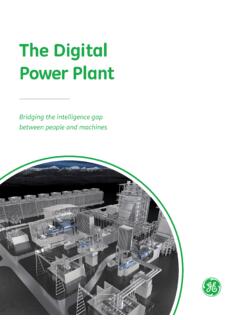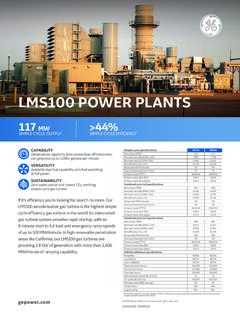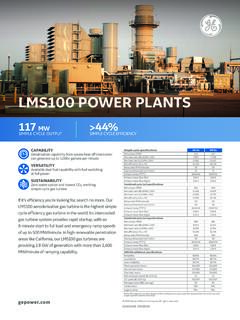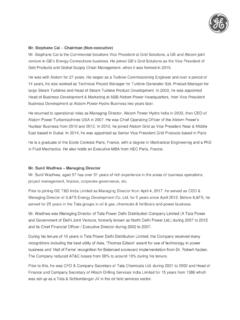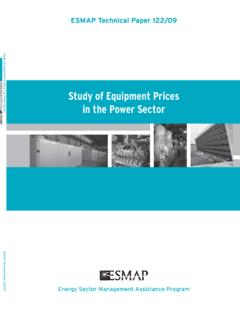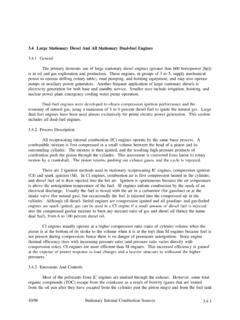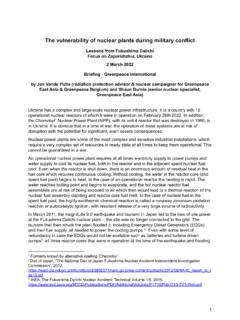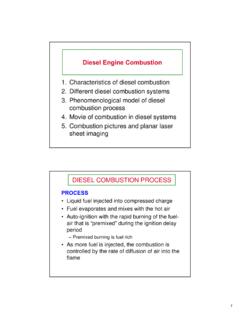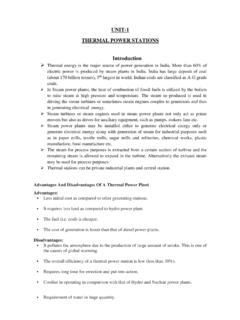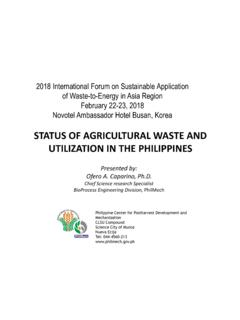Transcription of Hydrogen as a fuel for gas turbines - General Electric
1 Hydrogen as a fuel for gas turbinesA pathway to lower CO2 as a fuel for Gas Turbines2 The power sector s journey to decarbonize, often referred to as the Energy Transition, is characterized by rapid deployment of renewable energy resources and a rapid reduction in coal, the most carbon-intensive power generation source. Based on our extensive analysis and experience across the breadth of the global power industry, GE believes that the accelerated and strategic deployment of renewables and gas power can change the near-term trajectory for climate change, enabling substantive reductions in emissions quickly, while in parallel continuing to advance the technologies for near zero-carbon power generation.
2 Part of this deployment of gas power may involve the use of Hydrogen as a fuel in order to reduce CO2 of 2020 there were ~1,600 GW of gas turbines installed globally, and gas power accounted for ~22 percent of global electricity generated. The vast majority of gas turbines burn natural gas, or methane (CH4), to release energy which ultimately produces the electricity we use at home, schools, factories, in the community and for are two ways to systematically approach the task of turning high efficiency gas generation into a zero or near zero-carbon resource: pre and post-combustion.
3 Pre-combustion refers to the systems and processes upstream of the gas turbine and post-combustion refers to systems and processes downstream of the gas turbine . The most common approach today to tackle pre-combustion decarbonization is simple: to change the fuel , and the most talked about fuel for decarbonization of the power sector is is a world leader in gas turbine fuel flexibility, including more than 100 gas turbines that have (or continue to) operate on fuels that contain Hydrogen . This fleet has accumulated more than 8 million operating hours and produced more than 530 Terawatt-hours of electricity.
4 It includes a group of more than 30 gas turbines that Executive SummaryIn order to combat man-made climate change, there is a global need for decarbonization,* and all sectors that produce carbon dioxide (CO2) must play a believes that using Hydrogen as a fuel is one of the potential ways to decarbonize gas power generationhave operated on fuels with at least 50% (by volume) Hydrogen . These units have accumulated more than million operating hours, giving GE a unique perspective on the challenges of using Hydrogen as a gas turbine is continuing to advance the capability of its gas turbine fleet to burn Hydrogen through internally funded R&D programs and through US Department of Energy funded programs.
5 The goals of these efforts are to ensure that ever higher levels of Hydrogen can be burned safely and reliably in GE s gas turbines for decades to come.* Decarbonization in this paper is intended to mean the reduction of carbon emissions on a kilogram per megawatt hour as a fuel for Gas Turbines3 FIGURE 1: Means of decarbonizing a gas turbineIntroductionFigure 1 depicts the two methods for decarbonizing a gas turbine : pre and post-combustion. For pre-combustion decarbonization a fuel such as Hydrogen containing no carbon or a carbon neutral fuel such as biogas is burned in the gas turbine .
6 GE gas turbines have a long history of burning fuels ranging from Hydrogen , to natural gas and high molecular weight hydrocarbons, to diesel fuel , to crude oil. Each fuel has unique post-combustion decarbonization, there is a tool chest of different technologies that can remove CO2 from the flue gases with the most common being in a process referred to as carbon capture. The General concept of carbon capture involves introducing a specialized chemical which has an affinity to carbon into the plant exhaust stack. Once the CO2 and the chemical bond, the compound is taken to a separate vessel and separated into its constituents.
7 The resulting pure CO2 is taken to a compression tank and is ready for transportation. This CO2 is then transported to either a geologic formation deep underground for permanent storage, or re-used in industrial processes, thus completing the process of Carbon Capture and Utilization or Sequestration (CCUS).It s important to note that pre and post-combustion decarbonization approaches can be employed on existing installed gas turbines as a retrofit or included in the design of a new power plant, avoiding the potential lock-in of CO2 emissions for the entire life of the power INFRASTRUCTURE PRODUCTION, TRANSPORT, AND STORAGEH ydrogen is the most abundant element in the universe, but despite its plentiful nature it does not exist on earth as a standalone molecule.
8 In other words, Hydrogen likes to bond with other molecules. In order to yield pure Hydrogen , it must be separated from its paired molecules, usually found in the form of water (H2O), or hydrocarbons ( , CH4). More than 90% of the Hydrogen produced globally today uses natural gas or USE A ZERO OR CARBON NEUTRAL fuel Hydrogen (blue, green, pink) Synthetic (renewable) methane Biofuels Ammonia (NH3)REMOVE CARBON FROM THE PLANT EXHAUST Carbon capture (liquid solvents) Carbon capture (solid sorbents) Oxy- fuel cyclesPRE-COMBUSTIONPOST-COMBUSTION coal as a feedstock, typically in a process called steam methane reforming (SMR).
9 The SMR process produces CO2 as a by-product and most of this CO2 is released to the atmosphere. An alternative method of producing Hydrogen is through electrolysis in which a water molecule is broken into its Hydrogen and oxygen constituents by passing electricity through the water. No CO2 is produced directly by the electrolysis process, but depending on the fuel source of the electricity, CO2 could be color-based convention is being used internationally to describe and differentiate Hydrogen production methods: Grey (or black): Gasification of coal or reforming of natural gas without carbon capture Blue: Reforming of methane (SMR) with carbon capture and storage Green: Electrolysis of water using renewable power Pink (Red): Electrolysis of water using nuclear power Turquoise.
10 Pyrolysis of methane which produces Hydrogen and solid carbon as a by-product White: Gasification or other process using 100% biomass as a feedstockThe cost of Hydrogen produced by these different methods can vary widely, with grey (or black) typically being the least expensive. The price for Hydrogen produced using the electrolytic processes ( , green, pink, red) depends primarily on the cost of the electricity used in the process and the utilization rate, or capacity factor of the electrolyzers. A higher capacity factor tends to result in lower Hydrogen costs, all other factors being equal.
